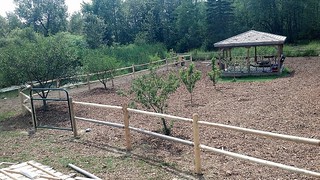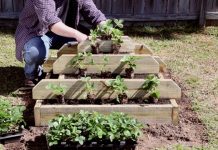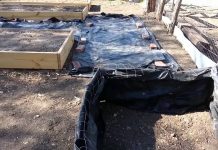The video above shows one of the simplest techniques for growing potatoes; the no dig method. There are so many different ways of building a small backyard garden that it can be hard to choose between them all; for example:
- Conventional Gardening
- Square Foot Gardening
- Double Digging
- Straw Bale Gardening
- Deep Mulching
- No Dig
- Vertical Gardening
- Aquaponics
- And the list goes on and on
Which one should you choose?
I always get a chuckle when I hear people try and tell others how to garden; it comes across like a used car salesman sometimes. Every location is unique; what works in one area doesn’t necessarily mean it will work everywhere. Different climates; soil conditions and a laundry list of other criteria will dictate how well a particular method will work. My personal recommendation is to experiment with different techniques and integrate the ones that work well; while ignoring the ones that don’t.
 Over the last decade we have experimented with many different methods; square foot gardening, stacked tires, vertical, traditional; three sisters and a bunch of others. Last year we didn’t even plant a garden; we spent all summer tearing everything up and started from scratch. 😯 We are still relatively young and want the ability to grow food in the most effective way possible for our particular conditions and now is the time to make mistakes; not when we are older. With this in mind we decided to try the deep wood chip method that has exploded in popularity since Paul Gautschi shared his experience in the documentary Back To Eden.
Over the last decade we have experimented with many different methods; square foot gardening, stacked tires, vertical, traditional; three sisters and a bunch of others. Last year we didn’t even plant a garden; we spent all summer tearing everything up and started from scratch. 😯 We are still relatively young and want the ability to grow food in the most effective way possible for our particular conditions and now is the time to make mistakes; not when we are older. With this in mind we decided to try the deep wood chip method that has exploded in popularity since Paul Gautschi shared his experience in the documentary Back To Eden.
Besides; I find that experimenting is half the fun of gardening. I will keep you updated on how the experiment works for us; now go get your hands dirty!
Gardening When It Counts: Growing Food in Hard Times
Designed for readers with no experience and applicable to most areas in the English-speaking world except the tropics and hot deserts, this book shows that any family with access to 3-5,000 sq. ft. of garden land can halve their food costs using a growing system requiring just the odd bucketful of household waste water, perhaps two hundred dollars worth of hand tools, and about the same amount spent on supplies — working an average of two hours a day during the growing season.






I leave one raised bed fallow every year. I think I may put this method into the rotation for the first year out of fallow. Let the layer of newspaper keep any weed seeds down and continue to compost all the yard waste from the previous year.
Sounds like an excellent plan Ash, let me know how it works for you.